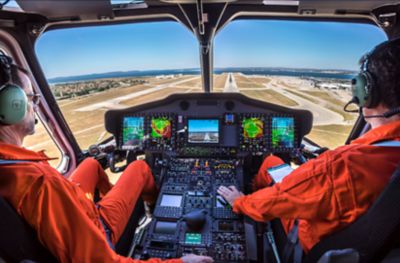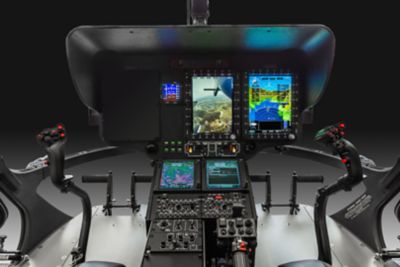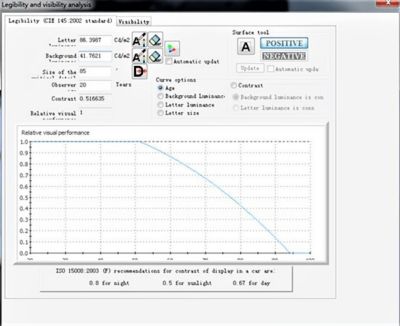-
-
学生向け無料ソフトウェアにアクセス
Ansysは次世代の技術者を支援します
学生は、世界クラスのシミュレーションソフトウェアに無料でアクセスできます。
-
今すぐAnsysに接続!
未来をデザインする
Ansysに接続して、シミュレーションが次のブレークスルーにどのように貢献できるかを確認してください。
国および地域
無料トライアル
製品およびサービス
リソースとトレーニング
当社について
Back
製品およびサービス
Ansysブログ
June 5, 2023
Airbus Helicopters社、Ansysのシミュレーションを活用してエネルギー効率が高く、セーフティクリティカルなコックピットを設計
強い直射日光、接近する車両のライト、あるいは雨による反射は、歩行者であっても気が散るものです。路上で車両を運転するドライバーであれば、そうした影響はさらに大きな問題となります。外装照明条件に加えて、内装照明も、ドライバーが車内のインジケータパネルの情報を読み取りにくくなる原因となります。では、空中で最適な飛行コースを確認するためにコントロールパネルを見ながら、夜間や厳しい気象条件の中でヘリコプターを操縦するパイロットにとって、そうした問題がどれほど難しいかを考えてみてください。最悪の場合、乗務員や乗客の安全性を確保できなくなることもあります。

Airbus Helicopters社のH175のコックピットと計器パネル
航空業界では安全が最優先事項であり、光学系の設計が重要な役割を担っています。さらに、気候変動への懸念が世界中で高まるにつれて、持続可能性の重要性も高まっています。アメリカ連邦航空局(FAA)や欧州航空安全機関(EASA)などの規制機関は、安全でエネルギー効率の高い製品を設計するようメーカーに義務付けています。こうした安全性と効率性に対する要求が高まったことで、多くのメーカーは設計を改善し、認証を迅速化するための新しいソリューションを模索するようになりました。
大手航空機メーカーのAirbus Helicopters社は、仮想テストとプロトタイプ作製を通じて、材料の無駄をなくし、消費電力や関連コストを削減しながら、パイロットの視認性とコックピットディスプレイをより改善するために、Ansysのシミュレーションソリューションを採用しています。Airbus Helicopters社は、光学系設計ソフトウェアであるAnsys Speosから得た重要な知見を適用することで、高い効率性と予測精度で航空規制基準を遵守しながら、コックピット設計を改善して効率化しました。

Airbus Helicopters社では、コックピットの光学系の設計と妥当性確認のためにAnsys Speosを導入した
シミュレーションで操作性を向上
Airbus Helicopters社のヘリコプターは、150を超える国と民間で採用されています。また、官公庁、軍事、法執行機関、民間、準公共機関向けのさまざまな回転翼航空機ソリューションを提供しています。自社の航空機の安全な運用を保証するために、同社は開発時に最高レベルの基準を遵守し、シミュレーションから貴重な知見を得て、それを設計に組み込んでいます。
Airbus Helicopters社は、Speosを導入したことで、コックピット設計時に人の視界を評価し、グレア、反射、歪みを引き起こす条件での挙動を予測できるようになりました。同社のエンジニアたちは、このデータを使用して、パイロットの視認性や、乗務員が読み取る画面表示の可視性を向上させています。
中型ツインエンジンH160、超中型ツインエンジンH175、ヘビーツインエンジンH225など、Airbus Helicopters社の多くのヘリコプターのコックピット視認性を向上させる設計において、Ansysのシミュレーションは極めて重要な役割を担っています。同社の航空機は、1人または2人のパイロットによって操縦され、最大で12人、18人、および19人の乗客を収容できます。また、同社は、ほぼすべての航空機の軍用モデルバージョンも設計しています。実際に、軍用モデルであるH160M、H175M、H225Mは、パイロットと乗務員の収容人数は異なるものの、それぞれ民間モデルをベースに設計されています。

Airbus Helicopters社の超中型ツインエンジンH175は、2人のパイロットと最大で18人の乗客を収容する
Speosでは、3Dプラットフォーム内で使いやすく直感的な機能セットが提供されます。これらの機能を使用して、レイアウトや形状を任意のCAD環境にシームレスに直接統合し、高い精度で可視化して、設計をゼロから作成したり、既存の設計を最適化したりできます。
Airbus Helicopters社のヒューマンファクターおよびヒューマンマシンインターフェース部門のエンジニアであるStephane Poveda氏は、次のように述べています。「コックピット内で生じる光の影響について、乗務員や認証機関に解析的な計算を説明するのは簡単なことではありません。しかし、Ansys Speosを使用することで、潜在的な影響を確認し、精度の高い視覚的レンダリングとシミュレーションを使用して、結果を担当者に見せることができます。これは、ヘリコプターの設計と認証において極めて有用です。特に、コックピット内のさまざまな照明条件が昼夜や天候によって変化することを説明するときに役立ちます。」
Ansys Speosの最も有用な機能の1つが、ヒューマンビジョンコンポーネントです。この機能により、設計者は個々の観察者に応じて、反射、可視性、視認性などの視覚的側面を決定できます。設計者は、この知見に基づいて、パイロットと乗務員にとってより安全な照明条件を設定できます。Speosで提供される精密なヒューマンアイ受光面モデルでは、輝度と360度没入型のオブザーバー結果を得るためのヒューマンビジョンアルゴリズムを使用できます。生理学的なヒューマンビジョンモデリングを使用することで、設計者は色、コントラスト、調和、光の均一性、強度を最適化しながら、昼夜の視覚など、周囲の照明条件を考慮することで、ディスプレイ表示の視認性を向上させることができます。

Ansys Speosは、精密なヒューマンアイ受光面モデルを使用して輝度をシミュレーションし、360度没入型のオブザーバー結果を提供します。
シミュレーション主導型設計による効率の向上
Speosで提供されるもう1つの有用な機能は、4,200件を超える光や材料のサンプルを含む広範な光学ライブラリです。このオンラインデータベースのサポートにより、Airbus Helicopters社は、設計時に効率性に優れた適切な材料を選択しています。さらに、エンジニアはSpeosの照明システム解析ツールを使用して、選択した材料が設計要件に適切であるかを確認し、業界標準や法的基準への準拠を検証できます。
AnsysのアプリケーションエンジニアリングマネージャーであるFabien Bastideは、次のように述べています。「Airbus Helicopters社がヘリコプター用の光学系を設計および最適化する上では、Ansys Speosのような高度な光学設計ソフトウェアツールが非常に有用です。最適化された機器の活用、材料選択の改善、高度なテクノロジーにより、航空機の製造プロセスに大きな価値が付加されます。」
さらに、最適化された機器と材料の選択により、メーカーは重量や性能に関するコンプライアンス要件をより簡単に遵守できるようになり、認証プロセスが加速します。同様に、Ansysの光学系設計解析を使用することで、リサイクル可能な新しい材料の振る舞いをモデル化して、これまでの照明をLEDに置き換えて消費電力を削減するなど、従来のテクノロジーをアップデートすることができます。
Bastideは、次のように述べています。「これらのツールを使用することで、視野、解像度、画質などのさまざまな要因を考慮し、異なる照明条件や環境要因でシステム性能をシミュレーションできるようになります。その結果、メーカーは発生しうる問題に関する貴重な知見を得ることで、十分な情報に基づいて設計に関する意思決定を行うことができます。」
Airbus Helicopters社は、材料の選択を改善し、仮想環境でのテストとプロトタイプ作製を増やしたことで、材料の無駄をなくし、実機試験や物理的なプロトタイプの作製にかかる時間、エネルギー、コストを削減することができました。さらに、SpeosのGPUコンピューティングにより、精度を損なうことなく、平均で140~260倍高速なベンチマークなど、シミュレーションパフォーマンスが大幅に向上します。

Ansys Speosには、設計者がヒューマンビジョンによる知覚に基づいて光学系を改善できる視認性および可視性解析ツールが含まれています。
航空機の未来を改善
航空業界全体で消費者の要求、安全規制、グローバルな持続可能性イニシアチブを満たすことを目指す中で、メーカーはデジタルトランスフォーメーションを活用しながら、開発の早期段階にシミュレーションを導入して、設計に有用な情報を活用しています。Airbus Helicopters社を始めとするメーカーは、Speosを導入することで、業界の要求を満たしながら、セーフティクリティカルなコックピット設計をより改善することができます。
Speosの詳細を確認するには、今すぐ無料トライアルに登録してください。